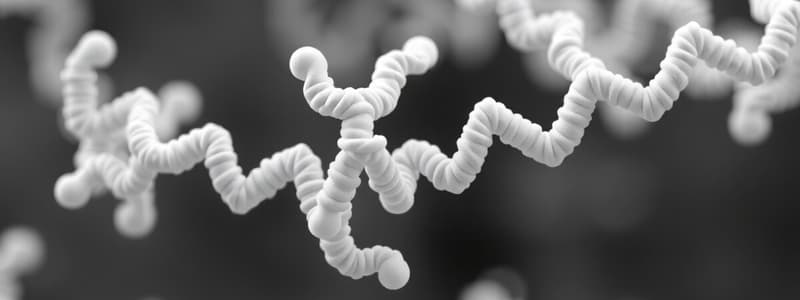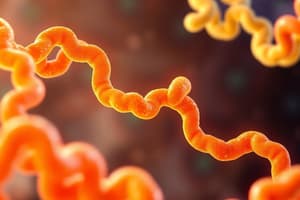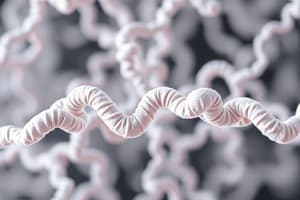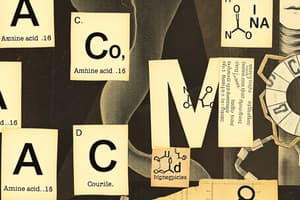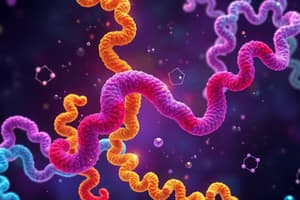Podcast
Questions and Answers
What is the Greek origin of the word 'proteins'?
What is the Greek origin of the word 'proteins'?
- protien
- proteios (correct)
- proteina
- proteine
What is the most abundant biomolecule in the cell?
What is the most abundant biomolecule in the cell?
Proteins
Proteins are the least versatile of the four biomolecules.
Proteins are the least versatile of the four biomolecules.
False (B)
How many amino acids are commonly found in proteins?
How many amino acids are commonly found in proteins?
Proteins function is determined by their ______.
Proteins function is determined by their ______.
Which two functional groups are present in amino acids?
Which two functional groups are present in amino acids?
Which of the following amino acids is branched chain?
Which of the following amino acids is branched chain?
What is the term for amino acids having a carboxyl and amino group attached to the same carbon atom?
What is the term for amino acids having a carboxyl and amino group attached to the same carbon atom?
Which of the following statements about amino acids is incorrect?
Which of the following statements about amino acids is incorrect?
What characteristic defines branched chain amino acids?
What characteristic defines branched chain amino acids?
Which group of amino acids does not include sulfurs in their side chains?
Which group of amino acids does not include sulfurs in their side chains?
Which structural classification of amino acids is characterized by the presence of a branched-side chain?
Which structural classification of amino acids is characterized by the presence of a branched-side chain?
Which combination of features does a typical amino acid exhibit?
Which combination of features does a typical amino acid exhibit?
Which pKa value represents the deprotonation of the α-carboxyl group in aspartic acid?
Which pKa value represents the deprotonation of the α-carboxyl group in aspartic acid?
What does the pKa value of 9.60 indicate about aspartic acid?
What does the pKa value of 9.60 indicate about aspartic acid?
Which of the following is the correct order of deprotonation steps for aspartic acid based on its pKa values?
Which of the following is the correct order of deprotonation steps for aspartic acid based on its pKa values?
Which pKa value is associated with the side chain of aspartic acid?
Which pKa value is associated with the side chain of aspartic acid?
What is the significance of knowing the pKa values of amino acids like aspartic acid?
What is the significance of knowing the pKa values of amino acids like aspartic acid?
Flashcards are hidden until you start studying
Study Notes
Proteins
- Proteins are the most abundant biomolecules in the cell.
- They are composed of a group of organic compounds called amino acids.
- Protein function is determined by protein structure.
Amino Acids
- Amino acids contain two functional groups: The amino group (-NH2) and the carboxyl group (-COOH).
- They are termed α-amino acids if both the carboxyl and amino groups are attached to the same carbon atom.
Amino Acid Classification
- There are 20 (+2) amino acids commonly found in proteins.
- Each amino acid is assigned a 3-letter or 1-letter symbol.
Classification Based on Structure
- Amino acids are categorized based on their side chain structures.
- Some commonly found categories include:
- Alkyl/Aliphatic amino acids: These have aliphatic side chains. They include Glycine, Alanine, Valine, Leucine, and Isoleucine.
- Sulfur-containing amino acids: These amino acids have sulfur atoms in their side chains.
- Acids, Bases, Aromatic, and Imines: These are further categories based on the properties and structure of the amino acid side chains.
Amino Acids
- There are 20 common amino acids found in proteins.
- Amino acids are represented by a three-letter or one-letter symbol.
Classification Based on Structure
- Amino acids are classified based on their side chains, which can be:
- Alkyl/Aliphatic
- Alcohols
- Sulfur-containing
- Acids + Amides
- Bases
- Aromatic
- Imines
Alkyl/Aliphatic
- Glycine, Alanine, Valine, Leucine, and Isoleucine are classified as alkyl/aliphatic amino acids.
- These amino acids have aliphatic side chains.
- They are monoamino monocarboxylic acids.
- Leucine, Isoleucine, and Valine are branched chain amino acids.
Aspartic Acid
- Aspartic acid has a pKa of 1.88 for the α-carboxyl group, 9.60 for the α-amino group, and 3.65 for the side chain.
Primary Structure
- Primary structure refers to the linear sequence of amino acids in a protein.
- This sequence forms the backbone of proteins (polypeptides).
- Peptide bonds link amino acids together.
Peptide Bonds
- Amino acids are held together by covalent peptide bonds.
- Peptide bonds are strong and act as the “cementing material” between amino acids.
- A peptide bond forms when the amino group of one amino acid combines with the carboxyl group of another amino acid.
- A dipeptide is formed from two amino acids with one peptide bond.
- The free amino end is written on the left and is called the N-terminal residue, while the free carboxyl end is written on the right and is called the C-terminal residue.
Secondary Structure
- Secondary structure refers to the three-dimensional shape of a protein.
- Secondary structures include:
- Alpha-helix
- Beta-sheet
Tertiary Structure
- Tertiary structure refers to the three-dimensional structure of a functional protein.
- Interactions between side chains influence tertiary structure.
- These interactions include:
- Hydrogen bonds
- Ionic Bonds
- Hydrophobic interactions
- Disulfide bridges
Quaternary Structure
- Quaternary structure refers to the arrangement of multiple polypeptide chains (subunits) in a protein.
- Examples of proteins with quaternary structure include:
- Hemoglobin
- Lactate dehydrogenase
- Aspartate transcarbomylase
Hierarchy of Protein Structure
- The hierarchy of protein structure is as follows:
- Primary structure
- Secondary structure
- Tertiary structure
- Quaternary structure
Classification of Proteins
- Proteins can be classified based on:
- Function
- Chemical nature and solubility
- Nutrition
Classification of Proteins by Function
- Proteins can be classified based on their function:
- Structural
- Enzymes (Catalytic)
- Genetic
- Storage
- Transport
- Contractile
- Hormonal
Classification of Proteins by Chemical Nature and Solubility
- Proteins can be classified based on their chemical nature and solubility:
- Simple proteins
- Conjugated proteins
Classification of Proteins by Nutrition
- Proteins can be classified based on their nutritional value:
- Complete proteins
- Incomplete proteins
Studying That Suits You
Use AI to generate personalized quizzes and flashcards to suit your learning preferences.
